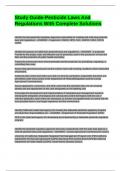Study Guide-Pesticide Laws And
Regulations With Complete Solutions
Identify the lead pesticide regulatory agencies responsible for creating and enforcing pesticide
laws and regulations. - ANSWER - 6 agencies: USEPA, DPR, CAC, USIPM, CDFA, SPCB,
CDPH,
Identify the purpose of California's pesticide laws and regulations. - ANSWER - 6 purposes:
Provide for the proper, safe, and effective use of pesticides used in the production of food and
fiber and the protection of public health and safety;
Protect the environment from environmentally harmful pesticides by prohibiting, regulating, or
controlling their uses;
Assure that agricultural and pest control workers have safe working conditions where pesticides
are present;
Authorize pest control and make sure that it is done by competent, responsible licensees and
permittees under strict control of the Department of PesticideRegulation and the County
Agricultural Commissioners;
Assure applicators, consumers, and other users that the pesticides they use are properly
labeled and are appropriate for the uses designated on the labeling; and
Encourage the development and implementation of integrated pest management systems,
stressing the integration of biological and cultural pest control techniques with the use of
selective pesticides, when these are necessary, to achieve acceptable levels of control with the
least possible harm to non-target organisms and the environment.
Identify California's state lead agency for creating the statewide pesticide regulatory program
and what their responsibilities are. - ANSWER - Department of Pesticide Regulation (DPR):
DPR is the state lead agency for developing and implementing a statewide pesticide regulatory
program.
Identify the pesticide regulatory agencies that work cooperatively with the state lead agency to
enforce pesticide laws and regulations. - ANSWER - County Agricultural Commissioners (CAC):
University of California, Statewide Integrated Pest Management Program (UC IPM):California
Department of Food and Agriculture (CDFA):Structural Pest Control Board (SPCB):California
Department of Public Health (CDPH), Vector-Borne Disease Section:
,Know the responsibilities of the Department of Pesticide Regulations Licensing and Certification
program. - ANSWER - U.S. EPA oversees and reviews state regulatory programs for
compliance with federal requirements, including the federal Worker Protection Standard. The
various states' regulatory programs may include these sub- programs:
• Certifcation and Training• Enforcement and Compliance• Worker Health and Safety•
Environmental Monitoring and Protection
Identify the documents, which contain California's pesticide laws and regulations. - ANSWER -
The State's pesticide use laws are in the California Food and Agricultural Code (FAC) Divisions
6, 7, and 13; the regulations are in Title 3, California Code of Regulations (3 CCR) Division 6.
Identify the requirements to become certified as a commercial pesticide applicator within
California. - ANSWER - In order to obtain a commercial pest control license or certifcate from
DPR, applicants must pass a core examination and pass at least one pest control category
examination to hold the following commercial pest control certifcates/licenses:
• Qualifed Applicator Certifcate (QAC)
• Qualifed Applicator License (QAL)
• Pest Control Aircraft Pilot Certifcate (PCAPC); and
• Agricultural Pest Control Adviser (PCA)
Identify the responsibilities of the County Agricultural Commissioner's regarding pesticide use
and the administration of private applicator certifications. - ANSWER - Generally, if an individual
meets the defnitionof a "private applicator" (see Glossary) theymust hold a valid Private
Applicator Certifcate. Although DPR develops the examination, the local CAC administers the
examination and issues the certifcate. This study guide is not intended for preparation for the
PAC examination.
Know the requirements to legally use a "restricted use pesticide." - ANSWER - Generally, DPR
requires that individuals possess applicator certifcation when using or supervising the useof
California restricted materials, which includes federal restricted use pesticides and certain other
pesticides
Know what the Federal Insecticide, Rodenticide, and Fungicide Act is and its association to
pesticide use, pesticide product registration, and the certification of pesticide applicators. -
ANSWER - The U.S. EPA regulates all aspects of pesticide registration, sale, and use at the
federal level through the laws in the Federal Insecticide, Fungicide, and Rodenticide Act
(FIFRA)
, and the regulations in the Code of Federal Regulations, Title 40 (40 CFR).
Identify pesticide labeling standards and who is required to meet these. - ANSWER - It is a
violation of federal law to use a pesticidein confict with its registered FIFRA Section 3or 24(c)
labeling or use directions issued under FIFRA Section 18 exemption.
Know when a pesticide label is required to be read by an applicator. - ANSWER - Before buying
the pesticide.Before mixing and applying the pesticide.When storing pesticides.Before disposing
of unused pesticide and empty containers.
Identify the federal and state agencies responsible for registering pesticide products. - ANSWER
- a pesticide product for sale, possession, or use, must frst register that pesticide product with
the United States Environmental Protection Agency (U.S. EPA) and then the Department
of Pesticide Regulation (DPR).
Identify the requirements to register a pesticide product in California. - ANSWER - DPR also
evaluates scientifc data for each pesticide during its registration process to determine if more
restrictions are required due to concerns specifc to California.
Explain why some pesticides are labeled as "restricted use" or "restricted materials" and where
a list of these products can be found. - ANSWER - This restricted use designation will impose
applicator certifcation requirements and possible additional application restrictions.DPR also
evaluates scientifc data for each pesticide during its registration process to determine if more
restrictions are required due to concerns specifc to California. These pesticides are designated
"California restricted materials"
Know the restrictions associated with a pesticide product whose registration has suspended,
lapsed, or been cancelled. - ANSWER - If the Pesticide Registrant allows a product registration
to lapse, a Pest Control Dealer who acquires the pesticide product while it was still registered
may sell and deliver it for two years after the last date of registration.
Know the types of pesticide product registration exemptions that are available. - ANSWER -
These different types of exemption registrations are often referred to by the FIFRA section
containing the requirements as:
general pesticide product registration
emergency exemptions from registration




